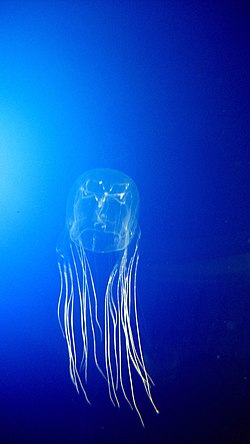| Chirodropidae | |
|---|---|
 | |
| Chironex sp. | |
| Scientific classification | |
| Domain: | Eukaryota |
| Kingdom: | Animalia |
| Phylum: | Cnidaria |
| Class: | Cubozoa |
| Order: | Chirodropida |
| Family: | Chirodropidae Haeckel, 1880 |
| Genera | |
| |
Chirodropidae is a family of venomous box jellyfish within the class Cubozoa. Like other members of the order Chirodropida, they have branched pedalia (muscular bases at the corners of their cubic umbrella), in contrast to the unbranched pedalia of box jellyfish in the order Carybdeida. Each branch houses its own individual tentacle. [1] Nematocyst composition and type can vary among individuals within this family based on body size and life stage. [2] Like other box jellyfish, chirodropids can be found in coastal and shallow marine areas, but they have also been found to occur at benthic depths. [3]
Contents
